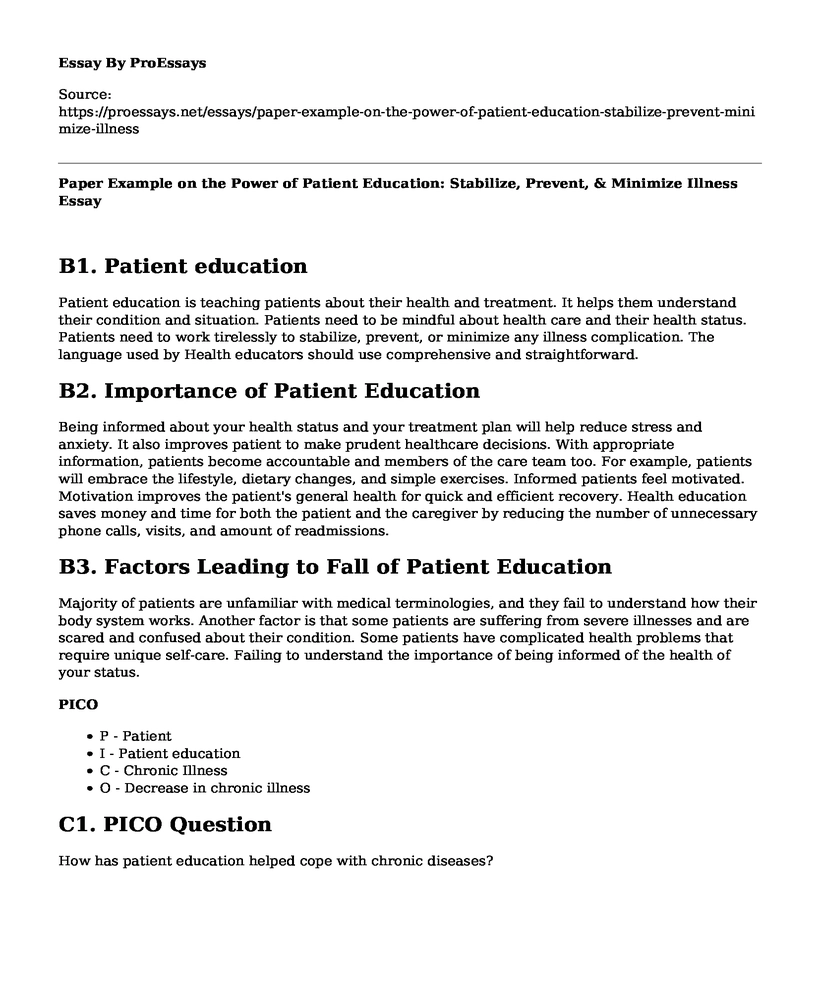B1. Patient education
Patient education is teaching patients about their health and treatment. It helps them understand their condition and situation. Patients need to be mindful about health care and their health status. Patients need to work tirelessly to stabilize, prevent, or minimize any illness complication. The language used by Health educators should use comprehensive and straightforward.
B2. Importance of Patient Education
Being informed about your health status and your treatment plan will help reduce stress and anxiety. It also improves patient to make prudent healthcare decisions. With appropriate information, patients become accountable and members of the care team too. For example, patients will embrace the lifestyle, dietary changes, and simple exercises. Informed patients feel motivated. Motivation improves the patient's general health for quick and efficient recovery. Health education saves money and time for both the patient and the caregiver by reducing the number of unnecessary phone calls, visits, and amount of readmissions.
B3. Factors Leading to Fall of Patient Education
Majority of patients are unfamiliar with medical terminologies, and they fail to understand how their body system works. Another factor is that some patients are suffering from severe illnesses and are scared and confused about their condition. Some patients have complicated health problems that require unique self-care. Failing to understand the importance of being informed of the health of your status.
PICO
- P - Patient
- I - Patient education
- C - Chronic Illness
- O - Decrease in chronic illness
C1. PICO Question
How has patient education helped cope with chronic diseases?
C2. Key Stakeholders
The key stakeholders in impacting patient education are nurses, nursing assistant, caregivers, physicians, and patients. Nurses and caregivers are more directly involved with the patients.
C3. Limitations of Patient Education
The language used in the medical field is a barrier since the majority of people are not familiar with medical terminologies. Level of patient illiteracy, some patients are not able to read or write. Disability like blindness or deafness can limit on from clearly getting the intended message. Since some don't know how to read the braille's and others don't understand the sign languages.
Time for learning is also a challenge. One will need time to attend for medical seminars, listen to health talks, and to do intensive research. Scarcity of qualified medics to organize for forums. Funds to host these forums is also another drawback. Quacks in the market have also made it difficult to achieve effective patient education. Patients are confused who is genuine and who is not.
C4. The solution to the Challenges
Government, organizations, and individuals should offer financial support to encourage medical research and motivate researchers. The government should also impose strict policies to punish those found with any malpractice. Mass media should take part in creating awareness about patient knowing their health status. Learning materials should be provided in soft and hard copy.
The learning materials should be made available and easily accessible. Most straightforward language should be used for easy understanding. Training of more staffs will be crucial so to meet the vast population. Caution should be taken when translating the content to avoid mixing thing and end up with a piece of contradicting information. Learners should be encouraged to seek further guidelines from physicians or nurses.
C5. Expected outcome
The real difference is anticipated if the suggested solutions will be obeyed. It will be necessary for the government and medical fraternity to have data and compare the initial and the current change. Different methods of analysis can be used, including qualitative and quantitative.
References
Berman, N. B., Durning, S. J., Fischer, M. R., Huwendiek, S., & Triola, M. M. (2016). The role of virtual patients in the future of medical education. Academic medicine, 91(9), 1217-1222.
MacLean, S., Kelly, M., Geddes, F., & Della, P. (2017). Use of simulated patients to develop communication skills in nursing education: An integrative review. Nurse education today, 48, 90-98.
Suikkala, A., Koskinen, S., & Leino-Kilpi, H. (2018). Patients' involvement in nursing students' clinical education: A scoping review. International journal of nursing studies, 84, 40-51.
Cite this page
Paper Example on the Power of Patient Education: Stabilize, Prevent, & Minimize Illness. (2023, Jan 23). Retrieved from https://proessays.net/essays/paper-example-on-the-power-of-patient-education-stabilize-prevent-minimize-illness
If you are the original author of this essay and no longer wish to have it published on the ProEssays website, please click below to request its removal:
- Infectious Diseases and Modern-Day Stressors Paper Example
- Essay Sample on The Story of Tori Degen
- Explanation of the Skin Disorder - Essay Sample
- ICT Revolutionizing Healthcare: Nurses' Perspectives - Essay Sample
- Combating COVID-19: A Capstone Project for Saving Lives - Essay Sample
- Freedom of Expression - Free Research Paper Sample
- Navigating Digital Transformation in Higher Education: Priorities in Language Learning During the Pandemic







